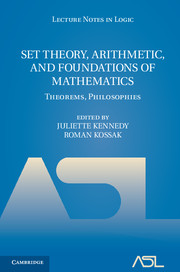Book contents
- Frontmatter
- Contents
- Introduction
- Historical remarks on Suslin's problem
- The continuum hypothesis, the generic-multiverse of sets, and the Ω conjecture
- ω-models of finite set theory
- Tennenbaum's theorem for models of arithmetic
- Hierarchies of subsystems of weak arithmetic
- Diophantine correct open induction
- Tennenbaum's theorem and recursive reducts
- History of constructivism in the 20th century
- A very short history of ultrafinitism
- Sue Toledo's notes of her conversations with Gödel in 1972–5
- Stanley Tennenbaum's Socrates
- Tennenbaum's proof of the irrationality of √2
- References
Hierarchies of subsystems of weak arithmetic
Published online by Cambridge University Press: 07 October 2011
- Frontmatter
- Contents
- Introduction
- Historical remarks on Suslin's problem
- The continuum hypothesis, the generic-multiverse of sets, and the Ω conjecture
- ω-models of finite set theory
- Tennenbaum's theorem for models of arithmetic
- Hierarchies of subsystems of weak arithmetic
- Diophantine correct open induction
- Tennenbaum's theorem and recursive reducts
- History of constructivism in the 20th century
- A very short history of ultrafinitism
- Sue Toledo's notes of her conversations with Gödel in 1972–5
- Stanley Tennenbaum's Socrates
- Tennenbaum's proof of the irrationality of √2
- References
Summary
Abstract. We completely characterize the logical hierarchy of various subsystems of weak arithmetic, namely: ZR, ZR + N, ZR + GCD, ZR + Bez, OI + N, OI + GCD, OI + Bez.
§1. Introduction. In 1964 Shepherdson [6] introduced a weak system of arithmetic, Open Induction (OI), in which the Tennenbaum phenomenon does not hold. More precisely, if we restrict induction just to open formulas (with parameters), then we have a recursive nonstandard model. Since then several authors have studied Open Induction and its related fragments of arithmetic. For instance, since Open Induction is too weak to prove many true statements of number theory (It cannot even prove the irrationality of √2), a number of algebraic first order properties have been suggested to be added to OI in order to obtain closer systems to number theory. These properties include: Normality [9] (abbreviated by N), having the GCD property [8], being a Bezout domain [3, 8] (abbreviated by Bez), and so on. We mention that GCD is stronger than N, Bez is stronger than GCD and Bez is weaker than IE1 (IE1 is the fragment of arithmetic based on the induction scheme for bounded existential formulas and by a result of Wilmers [11], does not have a recursive nonstandard model). Boughattas in [1, 2] studied the non-finite axiomatizability problem and established several new results, including: (1) OI is not finitely axiomatizable, (2) OI + N is not finitely axiomatizable.
- Type
- Chapter
- Information
- Set Theory, Arithmetic, and Foundations of MathematicsTheorems, Philosophies, pp. 80 - 92Publisher: Cambridge University PressPrint publication year: 2011



